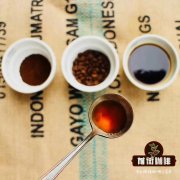Knowing the bitterness of bourbon coffee is not necessarily a bad bitterness

Professional coffee knowledge exchange More coffee bean information Please pay attention to coffee workshop (Weixin Official Accounts cafe_style)
Some people think that black coffee is bitter coffee, coffee bitter, has been controversial. Some people say: how to call coffee without bitterness? Some people say that good coffee has a pleasant bitterness.
Black coffee refers to coffee without modification, without added sugar creamer and other additives, including American, Italian espresso and single coffee.
Today we learn about single-origin coffee. As the name suggests, single-origin coffee comes from a specific place, usually as specific as a farm, cooperative or estate. The terroir of coffee is associated with the geographical location, climate, soil conditions, etc. of a particular location-giving each coffee a unique taste of single-source coffee.
Like drinking red wine, coffee is divided into many varieties, only two of which are truly commercially valuable and cultivated in large quantities, and the quality of coffee beans produced is also the highest among coffee beans produced by other coffee trees.
Coffee varieties can be divided biologically into Arabica, Robusta and Liberica. Arabica and Robusta are the main drinking varieties in the world. Generally speaking, Arabica is mainly used for single or fine coffee, and Robusta is used for instant coffee. Bourbon and tibeka are the two most important branches of Arabica coffee, both culturally and genetically.
Due to the low yield and susceptibility to disease of the tipica species introduced to Brazil in 1727, the bourbon species was introduced to Brazil around 1860 via Campinas in the south and rapidly spread north to other parts of South and Central America. In Latin America today, Bourbon is still cultivated in El Salvador, Guatemala, Costa Rica, Peru, etc., although most of the Bourbon species have been largely replaced by varieties (especially Caturra, Catuai, and Mundo Novo).
Red Bourbon After the general coffee tree blossoms, the color change of the coffee fruit is from: green> turn slightly yellow> turn slightly orange> turn mature red> turn ripe dark red, so some people call it "red bourbon species", in fact, red bourbon, that is, we generally call Bourbon species. Bourbon grown at high altitudes usually has a better aroma, a brighter acidity, and even a taste similar to red wine.
Bourbon is a coffee tree species belonging to a branch of Arabica species, generally bearing red fruit, called red bourbon, in addition to yellow bourbon, orange bourbon, yellow bourbon relatively low yield, but better quality.
In Africa, French missionaries known as Spiritans (from the congregation of the Holy Spirit) played an important role in the spread of bourbon. The first church was founded in Reunion in 1841 and a branch in Zanzibar in 1859; from Zanzibar, branches were founded in Bagamoyo (Tanzania coast, then Tanganyika) and St Augustine (Kikuyu, Kenya) in 1862 and a branch in Bura (Taita Hills, Kenya) in 1893. The establishment of each chapter is accompanied by the planting of coffee seeds brought from Reunion.
In 1899 Bura-bred seedlings were taken to another French church in Santa Cruz (near Nairobi), introduced to the Kilimanjaro region of Tanzania, and distributed seeds to local residents willing to grow coffee. The Kent species was introduced in 1920. So far, coffee in Tanzania has been dominated by bourbon and Kent.
Coffee variety: Bourbon, grown at 1000-2500 meters, with a refreshing acidity and medium body complemented by sweet citrus and floral aromas.
Related recommendations: How to hand brew Brazilian yellow bourbon coffee beans and red bourbon difference introduction
Important Notice :
前街咖啡 FrontStreet Coffee has moved to new addredd:
FrontStreet Coffee Address: 315,Donghua East Road,GuangZhou
Tel:020 38364473
- Prev

Are Ethiopian coffee beans suitable for hand brewing? How do Ethiopian coffee taste good?
Professional coffee knowledge exchange more coffee bean information please follow the coffee workshop (Wechat official account cafe_style) Ethiopia Jima Akmanu calendar solarization (organic certification) Ethiopia Jimma Akmel Nuri natural (organic certificated) producer: Ethiopia Ethiopia producing area: Limu Kosa; Jima Jimma producer
- Next

A list of the types of bourbon coffee what are the famous varieties of bourbon coffee
Professional coffee knowledge exchange more coffee bean information please follow the coffee workshop (Wechat official account cafe_style) [preface] after the early (prehistoric coffee) iron truck was transplanted to Yemen, the bean shape changed from thin to round. It was named bourbon in 1715 after France transplanted round beans from Yemeni mocha to the island of Bourbon on the east coast of Africa (renamed Reunion after the French Revolution).
Related
- Beginners will see the "Coffee pull flower" guide!
- What is the difference between ice blog purified milk and ordinary milk coffee?
- Why is the Philippines the largest producer of crops in Liberia?
- For coffee extraction, should the fine powder be retained?
- How does extracted espresso fill pressed powder? How much strength does it take to press the powder?
- How to make jasmine cold extract coffee? Is the jasmine + latte good?
- Will this little toy really make the coffee taste better? How does Lily Drip affect coffee extraction?
- Will the action of slapping the filter cup also affect coffee extraction?
- What's the difference between powder-to-water ratio and powder-to-liquid ratio?
- What is the Ethiopian local species? What does it have to do with Heirloom native species?

